By Theo Jung
Hello everyone, my name is Theo Jung and I’m here to help guide you through the early weeks of Phyrexia: All Will Be One’s draft format. I played in SCG Indianapolis, which was a 2-day Phyrexia: All Will Be One limited event. Day 1 consisted of 9 rounds of sealed and day 2 was 5 rounds of draft. I personally finished with a record of 8-5. While not a stellar record, I think I have learned a lot of things about this format both from preparing for and playing the event.
Outside of playing in the SCG, I have done about 7 practice drafts, about 4 of which were from using a proxy ONE cube that my friends in Madison made for testing. I want to include a disclaimer that this was written very early in the format, when 17 lands data was not available. However, I think a lot of core concepts in this article will continue to be sound.
Format Overview
This format is aggressive and rewards proactiveness, making aggro decks with a low curve the most successful in my experience.
As a result, combat tricks are better than you might expect. In a lot of situations, getting your opponent with a trick felt game-ending and I couldn’t find many situations where I could afford to play around them. Your opponent is often pressured to block more often than not in this format—especially with toxic being so prevalent and three poison threshold powering up cards with corrupted.
Another point in their favor is that most combat tricks in this format have some sort of added benefit associated with them, so it’s fairly common you get some advantage in addition to eating your opponent’s creature. Examples include proliferate on Whisper of the Dross, a card off of Blazing Crescendo, and Compleat Devotion staying in play after it has been used as a trick.
Creatures in this format are on the smaller side, meaning that cards like Whisper of the Dross, Hazardous Blast, Ambulatory Edifice, or anything that is hostile to X/1s can be quite effective.
Early in the format, my sense is that the format is very bomb-heavy—but the majority of game-ending ones cost six or seven mana. Examples include Kaya, Intangible Slayer, The Eternal Wanderer, and the “X Sun’s Twilight” in each color: White Sun’s Twilight, Blue Sun’s Twilight, Black Sun’s Twilight, Red Sun’s Twilight, and Green Sun’s Twilight. You can play a slower deck if you have one of these.
Otherwise, drafting midrange piles or piles with three or more colors is not advisable. Splashes are generally worse on average than a high synergy two-color deck. In a format as aggressive as this one, there are real costs to splashing that your more aggressive opponents will expose. Taking Turn 2 off to spend two mana to cast a Prophetic Prism, for example, has a higher cost than normal when most opponents are spending their first three turns adding pressure to the board. Drafting with a splash in mind and then cutting it during deckbuilding happened fairly often for myself and several people I have talked to, as well.
Color and Archetype Overview
As for the colors, most cards in each color only contribute to one of the color’s two synergies: Toxic, Oil, artifacts matter, equipment, or Proliferate. Red may be the exception, though, in that none of your cards contribute to toxic—which honestly makes the color a lot more internally cohesive. As a result of the colors being partitioned, mono-color decks are rare. Even if you have a good chunk of cards in one color, you only want to play the ones that contribute to the primary synergy your deck is trying to leverage.
Blue is very weak. Your creatures are understatted and your interaction is terrible or nonexistent. Mesmerising Dose—the only removal spell at common for Blue—suffers from all the issues bind effects do in Limited while also costing a hefty three mana…in a fast format. However, there are ways to build good aggressive Blue decks that are centered around artifacts so the color is not completely hopeless.
One thing that helps me when navigating a draft in this set is conceptualizing it as a cube with three main synergy packages. Given Blue proliferate has been quite poor, I find it helpful to ignore it. Therefore, I only really consider the other the three synergy packages: Oil (Red/Green/Black), Toxic aggro (Green/White/Black), and artifact aggro (Blue/White/Red).
Tentative Color Pair Archetype Rankings
Tier 1: I am actively looking to be in these archetypes.
- Red/Green Oil
- Black/White Toxic
- Green/White Toxic
Tier 2: These color pairs feel a little more disjointed, but they can be great if supported. I am much less confident in the ordering within this tier.
- Red/White Equipment
- Red/Black Oil (with a side of sacrifice)
- Green/Black Toxic
- Blue/White Artifact Aggro
- Blue/Red Artifacts and Spells
Tier 3: I would avoid drafting these color combinations if possible.
- Blue/Green Poison Proliferate
- Blue/Black Proliferate Control
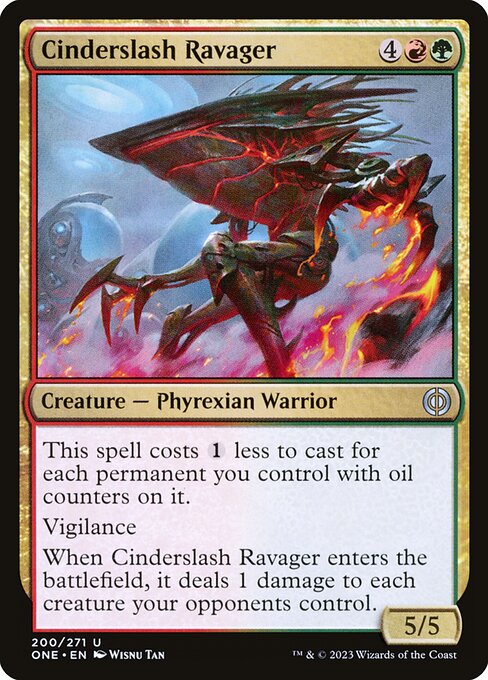
Red/Green Oil
The Red/Green color pair is primarily an Oil-based deck. Both Red and Green strongly support Oil, and being Green has upsides in a format where creatures are relatively understatted.
This archetype has a strong early game and has the tools to grind. I strongly believe drafting a good version of this deck is one of the best things to be doing. RG had great results in both testing and SCG Indianapolis, with the winner being in this archetype for almost the entire tournament.
If I had to name a downside of trying to draft this deck, it is that the really powerful cards in this deck are uncommons: Evolving Adaptive, Incubation Vat, Urabrask’s Anointer, and Cinderslash Ravager, and Churning Resevoir. As a result, this deck comes together a bit less often than the White toxic aggro decks that are more strongly supported at common.
When drafting this deck, I would avoid Green cards that contribute to Toxic synergies and Red filler that doesn’t contribute to Oil.
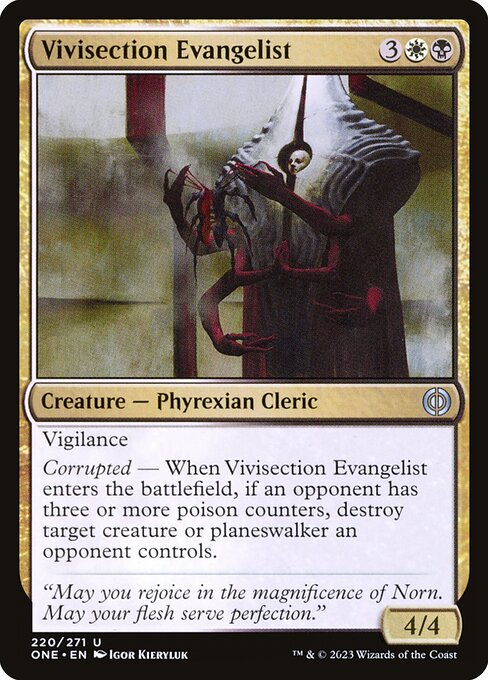
Black/White Toxic
Black/White wants to be Toxic aggro with a low curve. Both Black and White have significant support for Toxic, making this color pair very cohesive.
Unlike Red/Green, a lot of the core cards and powerful cards are available at common—Flensing Raptor, Crawling Chorus, Duelist of Deep Faith, Incisor Glider, Pestilent Siphoner, and Stinging Hivemaster are all solid cheap toxic creatures at common.
Additionally, tricks such as Compleat Devotion and Zealot’s Conviction punish your opponents for trying to block your Toxic creatures, which they are often incentivized to do.
As a result, good versions of this deck come together more often than Red/Green if White toxic cards are not heavily contested.
One downside to this deck is that your creatures are somewhat understatted. Crawling Chorus looks silly if your opponent has a Turn 1 Rustvine Cultivator or something of the sort. Combat tricks and Incisor Glider address this issue somewhat, but there will be situations where you don’t draw them and your creatures line up poorly against your opponent’s.
When drafting Black/White, I would keep in mind that this deck wants to be very lean. Cards like Indoctrination Attendant and Basilica Shepherd seem great but I would prioritize early plays over them and fill out the top of your curve later. Common traps when drafting this deck include going too heavy on the Black proliferate package and picking White equipment/artifacts matter cards.
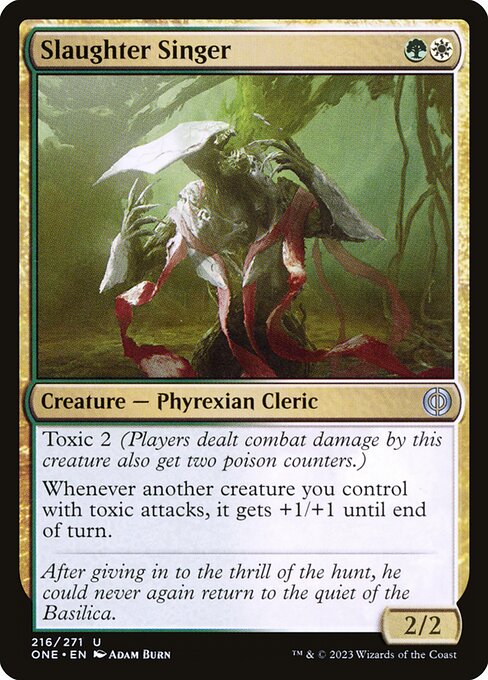
Green/White Toxic
Green/White should look very similar to Black/White, in that it is a Toxic aggro with a low curve and lots of tricks.
One added benefit of pairing Green with White (rather than Black) is that your creatures have slightly better stats on average than Black creatures, but the downside is that you won’t end up wanting half the Green cards you see since the color is split between cards that support Toxic and those that support Oil.
The Green uncommons are particularly strong in Toxic. Aside from Slaughter Singer, other hits include Venomous Brutalizer, Viral Spawning, and Infectious Bite. However, Black has slightly better support for Toxic at common which is why I rate this color pair a tier lower than Black/White.
Common traps while drafting this color pair include taking too many Green Oil cards, and picking White artifact matters cards/equipment.
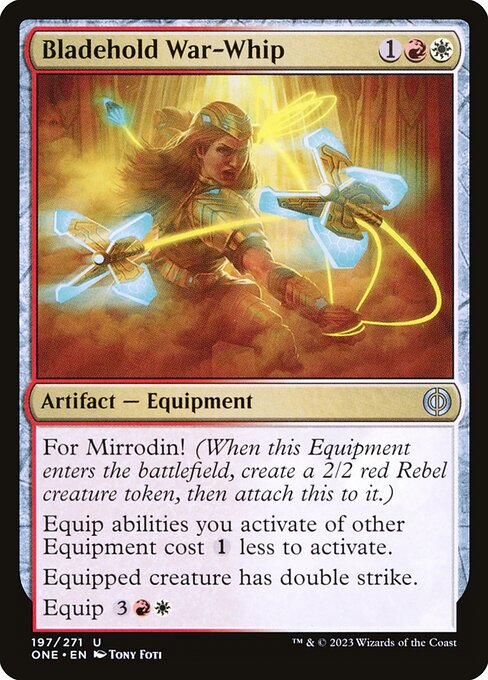
Red/White Equipment
Red/White is the equipment color pair that can either dip into artifact aggro synergies from White or minor Oil stuff from Red.
A good version of this deck is very powerful. Bladehold War-Whip is very strong, as 2/2 double striker beats most early drops in this format in combat. Red and White have a lot of early plays and can play aggressively, which is where you want to be in this format and thus improving the archetype relative to the others.
However, this color pair does have some prominent weaknesses. First, there is a tension between the two colors as White really wants to poison people and Red really doesn’t. This means you don’t want half the White cards you see, and the White cards that are designed to be in this archetype are not particularly good. Mirran Bardiche and Goldwarden’s Helm are both pretty poor on rate, and Infested Fleshcutter costs a lot of mana for a pretty irrelevant ability in Red/White. On the other hand, both of the Red equipment cards at common, Vulshok Splitter and Barbed Batterfist, are solid.
One card that has stood out in this archetype is Indoctrination Attendant, as bouncing your own equipment nets you another 2/2 rebel. I often get into this deck when I pick Red cards initially but find that Oil is fairly contested at the table, while I’m getting non-Toxic White cards late.
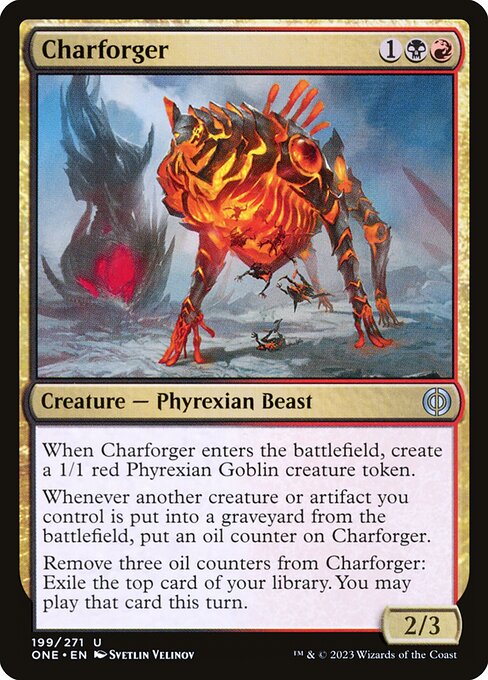
Red/Black Oil (With a Side of Sacrifice)
Red/Black wants to primarily be in oil, but can also leverage some sacrifice synergies. I most often draft this deck when I start out picking some strong Red Oil cards, but Green isn’t very open.
Red/Black is rated lower than the Red/Green version of Oil since Black is a much worse support color than Green for Oil, but there are some real rewards to being Black. First, the removal in Black is excellent at common, with Annihilating Glare and Anoint with Affliction covering a lot of ground. Second, Charforger and Necrosquito are both excellent uncommons for Red/Black that not many other archetypes want.
I have also been very impressed with Cutthroat Centurion in this archetype, as many creatures in this format struggle to beat a 4/4 in combat. Barbed Batterfist and stray mite tokens make excellent fodder for it. Awaken the Sleeper is the Act of Treason variant in this set, so look out for that card if you have a couple sacrifice outlets.
A trap when drafting this deck is leaning hard on the Black Toxic package, as Red does not contribute to it.
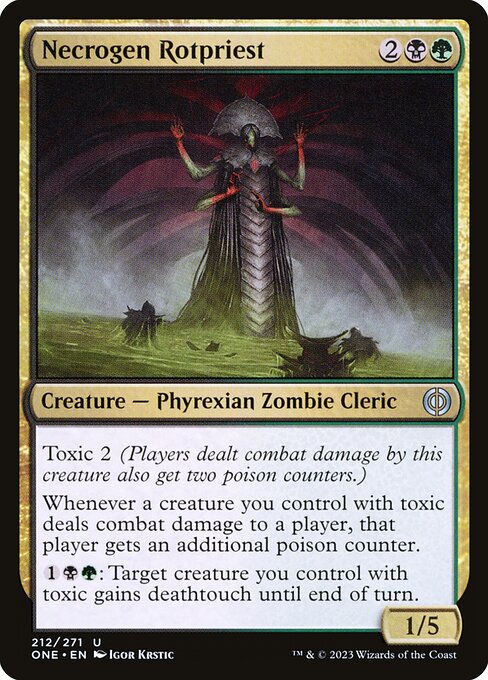
Green/Black Toxic
Green/Black wants to be a Toxic deck, similar to Green/White and Black/White. While you lose access to great commons like Crawling Chorus and Flensing Raptor, but you get a completely busted signpost uncommon in the form of Venerated Rotpriest.
I rated this deck lower than the White-based Toxic decks since I think the cheap White cards at common are very powerful and fit the speed of the format well, but Black is decent enough at supporting the Toxic theme and there are some powerful Green cards you have access to. Black removal and creatures with good stats in Green are upsides as well.
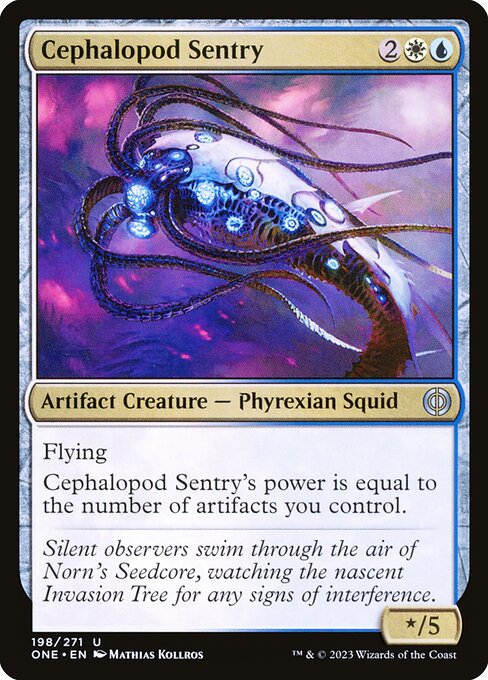
Blue/White Artifacts Aggro
The main theme for Blue/White is artifact-centric aggro.
A big upside of drafting this color pair is that you will most likely have a plenty of Blue cards to pick from, as Blue is the weakest color and therefore tends to be open quite frequently. Eye of Malcator is a key build-around for the Blue artifact shell, as a 4/4 outsizes most creatures in this format and Blue/White can consistently trigger it. Unctus’s Retrofitter—in a deck that supports it—feels incredibly good and you should take it highly in Blue artifact aggro decks.
The White cards in this deck don’t tend to be extremely contested either, with Icon of Ancestry, Basilica Spellbomb, and Mandible Justicar not being high picks in most other archetypes.
One downside is that you do not want a fair chunk of the White Toxic cards and you do not want any Blue proliferate cards. Therefore, you have to be the only person trying to draft this color combination for it to be viable.
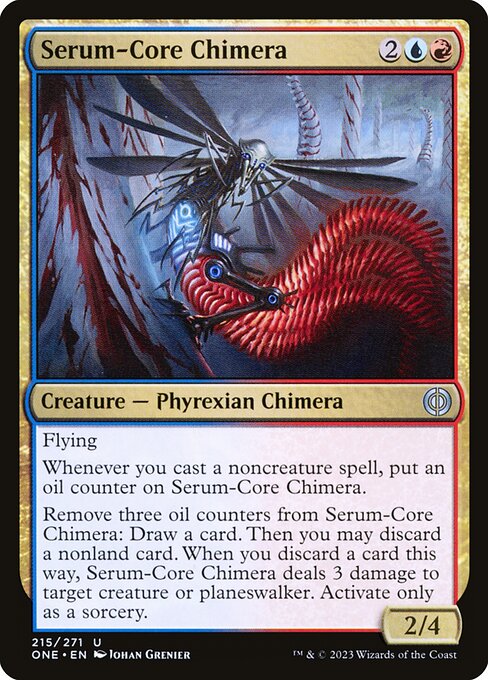
Blue/Red Artifacts and Spells
I haven’t had much experience with this archetype, but Serum-Core Chimera is powerful enough for me to consider Red/Blue as a contender. Leaning hard on the Blue proliferate package seems pretty weak, but being an artifact aggro deck that sometimes leverages oil synergies would be my best guess on how to properly draft this archetype. Unctus’s Retrofitter seems great here, as well, while Barbed Batterfist is a low-cost way to get a cheap artifact into play for it.
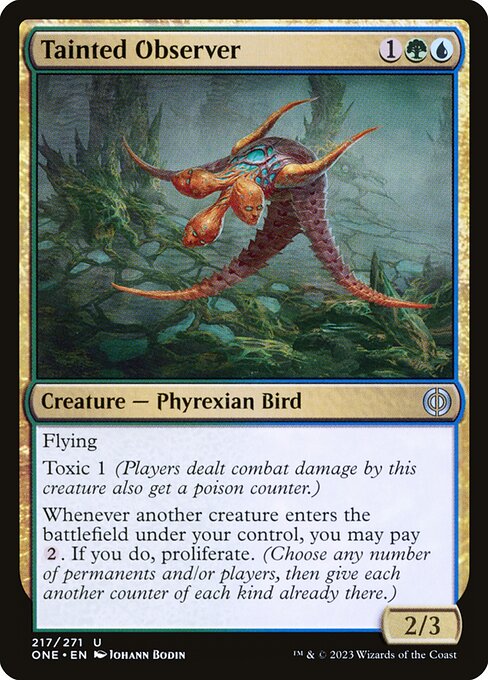
Blue/Green Poison Proliferate
I am unsure what good versions of this deck looks like. No one really has had success with this color combination in testing or practice but Tainted Observer seems really strong. Blue is poor at supporting Toxic and Green is poor at supporting Blue artifacts (or Proliferate), which I think is what you want to be doing in those respective colors. I would lean towards avoiding this color combination for now.
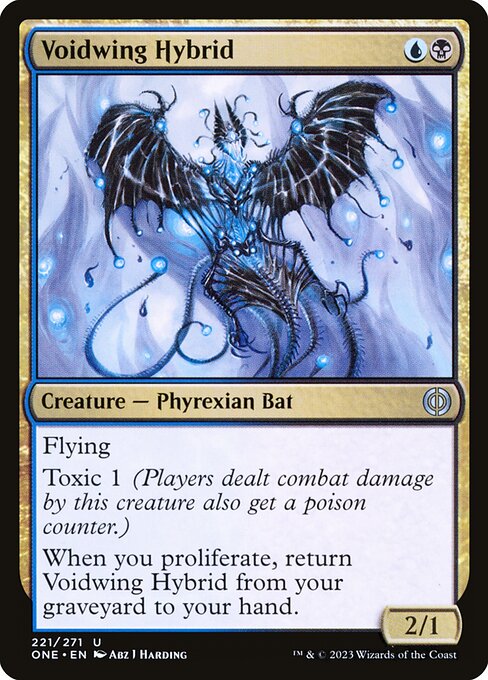
Blue/Black Proliferate Control
I would hard-avoid Blue/Black for now, as I have never seen a good version of this deck even after multiple tries. Black Proliferate control is absolutely not what you want to be drafting in this format, as you often lack good early plays on defense and ways to close the game without bombs.
There are similar problems to Blue/Green in that Blue is poor at supporting Toxic aggro but the signpost uncommon in Blue/Black, Voidwing Hybrid, is weaker.
Conclusion
Nothing in this guide is definite—Draft formats are self-correcting, making them very dynamic with new things wrinkles discovered throughout the life of a format. These are just ideas that have been helpful for myself and some others when approaching Phyrexia: All Will Be One Draft.
The most important thing, especially in a new limited format, is to keep trying new ideas that go against conventional wisdom of the format. Those ideas will often fail more than they will succeed, but you learn more by trying the unconventional ideas than drafting the same color combination for the sixth time.
Lastly, I would like to thank Sam Black for coordinating ONE cube sessions before the set was released and the folks in Madison for preparing. I would not have nearly as good a grasp of the format if it weren’t for those sessions.
If you have any questions or feedback regarding this article, feel free to message me on Twitter @wheredmyjuulgo. Thanks for reading!

